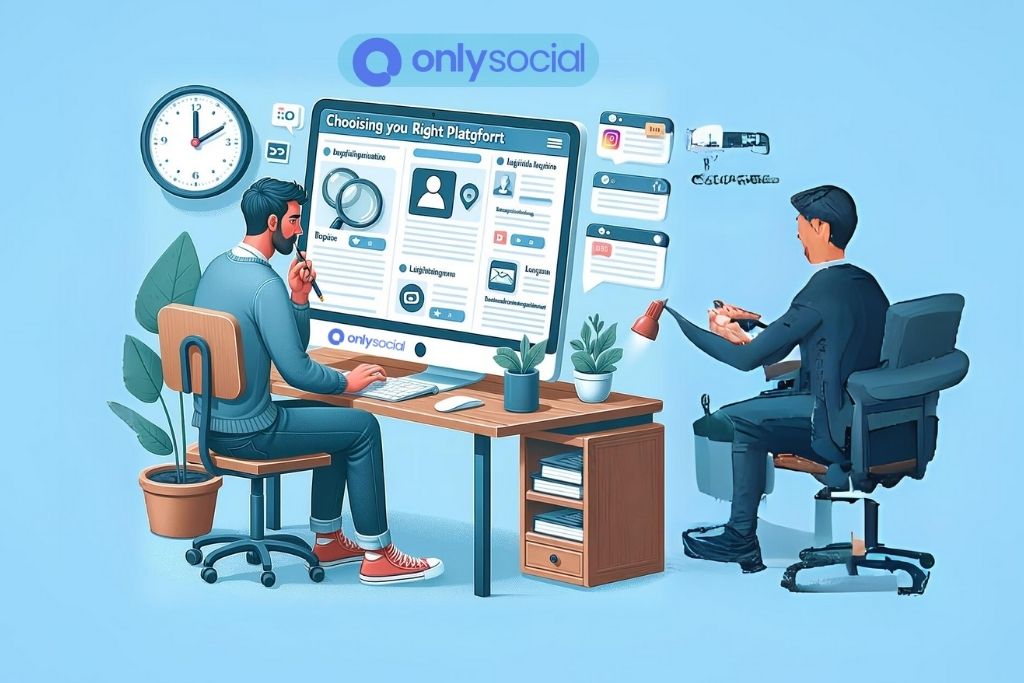The Step-by-Step Blueprint for Building Private Online Groups in 2024

In today’s interconnected world, building private online groups has grown increasingly popular as people seek close-knit, secure, and focused spaces to communicate or collaborate with like-minded individuals. Whether it’s for niche hobbies, professional development, or simply interacting with friends and family, the creation of private groups offers countless avenues for fostering deeper connections.
From enhancing networking opportunities to expanding on topic-specific knowledge, exploring ideas or getting tailored support from peers, private groups provide an inclusive and safe haven for genuine relationships. Moreover, they allow members to share their thoughts without the noise and distractions of a public forum. With privacy concerns on the rise, these private rooms offer a much-needed sense of security in an overwhelming digital landscape.
This comprehensive guide on building private online groups will help you navigate through the process, from selecting the right platform and setting up your group to inviting members and ensuring a thriving, engaged community. So, let us embark on this exciting journey and create a private online space you can be proud of.
Table of Contents [show]
Why You Should Consider Building Private Online Groups
As a society that thrives on connection, we often seek out communities that align with our interests, values, and needs. Private online groups provide a perfect setting for such communal interactions, bringing people together from different corners of the world under one digital roof. Here are some compelling reasons why building private online groups could be beneficial for you:
Tailored Content and Focused Discussions
Creating private online groups allows you to charter the conversations towards specific topics or interests. It helps eliminate distractions and irrelevant content, ensuring that the conversations stay focused, and members gain value from every interaction.
Enhanced Privacy and Control
Security is paramount in the digital world. Building private online groups gives you and your members a safer space where you have control over who joins the group, what content gets shared, and how discussions are managed.
Superior Engagement
Private groups often harbor deeper and more meaningful conversations, leading to high engagement rates. Members are more likely to contribute when they feel part of a secure, like-minded community.
Foster Strong Relationships
These groups serve as a platform to build robust relationships, promote mutual support, and foster a sense of belonging among members. It can be a nurturing space where members feel comfortable sharing their thoughts, experiences, and ideas.
Generate Business Opportunities
For businesses, private groups can be a powerful tool for customer engagement, lead generation, and customer service. A well-managed group can boost brand loyalty and foster a sense of exclusivity around your products or services.
| Benefits of Building Private Online Groups | |
|---|---|
| Tailored Content and Focused Discussions |  |
| Enhanced Privacy and Control |  |
| Superior Engagement |  |
| Foster Strong Relationships |  |
| Generate Business Opportunities |  |
In the sections that follow, we will delve into how to select the right platform for your group, important considerations when setting it up, and tips for nurturing an engaged community. Let’s move forward with our guide to building private online groups and unlock the multitude of advantages it offers.
Choosing the Right Platform for Building Private Online Groups
One of the first and most crucial steps to building private online groups is selecting the appropriate platform. The right choice should meet the unique needs of your community, from the type of content being shared to the scale of your group. Here, we will explore some of the most popular platforms used in building private online groups, with their respective pros and cons.
Facebook Groups
Facebook is a universally recognized platform boasting a wide range of features suitable for various groups. The platform allows granular privacy settings and a bevy of moderation tools, making it a great option for both large and small-scale communities.
Pros:
- Vast user base, increasing the potential for group members
- Robust moderation tools
- Supports various types of content (text, images, videos, polls)
Cons:
- Privacy concerns, given Facebook’s record
- Limited customization options
- Members need a Facebook account to join
LinkedIn Groups
For professional development or business-oriented communities, LinkedIn is an ideal choice. This platform offers a formal and career-focused environment, perfect for B2B networking or industry-specific discussions.
Pros:
- Ideal for professional and career development groups
- Members likely to take conversations seriously
- Can boost business or personal brand visibility
Cons:
- Less versatile with content type
- Less focused on community building, more on professional networking
- Requires a LinkedIn account to join
Slack
Slack is a powerful tool for creating private, chat-oriented groups. It’s particularly useful for agile communication within teams or smaller communities.
Pros:
- User-friendly interface
- Customizable and flexible
- Ideal for small to medium-sized groups
Cons:
- Not suitable for large communities due to its chat-based nature
- Administrative settings can be complex
- Requires Slack account or email invitation to join
| Platform | Pros | Cons |
|---|---|---|
| Facebook Groups | Large user base, various content types, robust moderation tools | Privacy concerns, limited customization |
| LinkedIn Groups | Ideal for professionals, serious conversations, boosts visibility | Less versatile, not community-focused |
| Slack | User-friendly, customizable, suitable for small communities | Not suitable for large groups, complex settings |
After choosing a platform for building private online groups, the actual creation process begins. But that’s a story for the next section.
Step-by-Step Process to Build Private Online Groups
Once you have chosen the perfect platform for your group, it’s time to start building your online community. Here’s a step-by-step guide to help you navigate the process of building private online groups:
1. Defining the Purpose
Begin by determining the core objectives and purpose for creating your private group. This might include sharing professional resources, discussing a niche hobby, offering support to each other, or building a closed community for friends and family. A clear purpose helps set the foundation for your group, providing direction for its growth and development.
2. Choose the Platform
Select the platform that best aligns with your group’s requirements, such as user demographics, privacy options, communication style, and content versatility. Refer to the previous section for guidance on popular platforms and their pros and cons.
3. Set up the Group
Follow the steps below based on the respective platform:
- Facebook Group: Click on the “+” icon at the top of your Facebook homepage. Select “Group” from the dropdown menu, enter the group name, and customize the privacy settings (private or public visibility).
- LinkedIn Group: Click on the “Work” icon at the top of your LinkedIn homepage. In the dropdown menu, select “Groups,” then click “Create a new group.” Fill in the required details and save your settings.
- Slack: Visit Slack.com and click “Get Started,” followed by “Create a new workspace.” You will need to enter your email address and follow the prompted steps to create your workspace.
4. Customize the Group
Create a unique and visually appealing group design by customizing the banner, profile picture, and description. This helps enhance your group’s identity, making it more attractive and memorable to potential members.
5. Implement Privacy Settings and Guidelines
Establish rules and guidelines for the group, such as posting etiquette, content restrictions, and banning policies. Configure privacy settings according to your group’s requirements, limiting access to the group and approving new member requests if necessary.
6. Inviting Members
Invite potential members through email invitations or by sharing a direct link to your group. Personalize your invitations, briefly outlining the group’s purpose and what the invitees stand to gain by joining.
7. Engaging the Group
Once members have joined, maintain a lively and engaging atmosphere. Start discussions, share resources, ask questions, and encourage member participation. Set the tone for interaction and create a safe space for open communication. Regular engagement is key to fostering a thriving community.
| Step | Description |
|---|---|
| 1. Define the Purpose | Decide on the group’s core objectives and goals |
| 2. Choose the Platform | Select the platform that best meets your group’s requirements |
| 3. Set up the Group | Create the group using the respective platform’s process |
| 4. Customize the Group | Add visual design elements and group descriptions |
| 5. Implement Privacy | Set privacy settings and establish group rules and guidelines |
| 6. Inviting Members | Invite potential members through email or a direct link |
| 7. Engaging the Group | Encourage and maintain member participation and interaction |
Now that you’ve created your private online group, the next step is ensuring your group flourishes by effectively moderating and managing it.
Best Practices for Moderating Private Online Groups
Building private online groups extends beyond the setup stage. Effective moderation is key to driving engagement and growth, while ensuring a positive environment for members. These best practices for moderating private online groups will help maintain a thriving and harmonious community:
1. Establish Clear Rules
Create clear group rules outlining what is expected of members. This may include posting guidelines, a code of conduct for interactions, or restrictions on content. To get members familiar with the rules, pin them at the top of your group or share them upon entry.
2. Active Moderation
Regularly monitor discussions within the group. This helps prevent conflict, uphold group rules, and deter spam or offensive content. Quick responses to rule violations show that you take the group seriously, encouraging members to do the same.
3. Encourage Engagement
Drive member engagement by starting interesting discussions, posing questions, and sharing valuable content. Reward active members by acknowledging their contributions, highlighting their posts, or giving a shoutout to them. Creating a sense of camaraderie encourages ongoing engagement.
4. Be Transparent
Transparency is crucial in moderation. If you need to remove a post or reprimand a member, explain your reasoning to the group. This not only maintains trust but also reinforces the importance of rules.
5. Resolve Conflicts Tactfully
In cases of misunderstandings or conflicts among members, tactfully step in to mediate. Encourage respectful debate and remove offensive comments. Sometimes, it might be necessary to take conversations offline or to private messages to resolve disputes.
6. Regular Updates
Post regular updates about the group, any changes to rules, and interactive content like polls or events. This keeps members informed and excited about being part of the community.
| Practice | Description |
|---|---|
| Establish Clear Rules | Outline member expectations and behavior guidelines |
| Active Moderation | Monitor discussions regularly and address violations promptly |
| Encourage Engagement | Drive member interaction through various initiatives |
| Be Transparent | Explain moderation actions to maintain trust |
| Resolve Conflicts Tactfully | Mediate disputes and maintain respectful interactions |
| Regular Updates | Provide frequent information about the community and its activities |
In implementing these best practices, you cultivate a welcoming space that encourages engagement, resulting in a supportive and productive private online group.
Case Studies of Successful Private Online Groups
Building private online groups accomplishes various goals from brand promotion, knowledge sharing, to forging community spirit. Here are examples of successful private online groups that have utilized the platforms to their advantage:
1. Peloton Member Page (Facebook Group)
Founded as an online fitness community for Peloton owners, this group boasts over 350,000 members sharing their workout stories, giving advice, and helping each other stay motivated. Peloton recognizes this community as a valuable marketing tool, offering firsthand insights into user experiences and concerns.
Key Success Factor: Active member engagement wherein the group encourages users to share personal stories and triumphs, creating a supportive, positive environment for fellow fitness enthusiasts.
2. SaaS Growth Hacks (Facebook Group)
This group was formed to create a space for entrepreneurs to share growth hacks, especially in the SaaS space. With over 20,000 members, the group is a thriving hub of knowledge exchange, networking, and mutual support.
Key Success Factor: Quality over quantity—members are vetted for their expertise and engagement in the SaaS industry, maintaining a high standard of shared content and discussions.
3. Remote Work & Jobs for Parents (LinkedIn Group)
This group connects parents looking for remote work opportunities and tips for juggling parenting responsibilities and work. The group’s success lies in its relatable theme—an empathetic space for working parents dealing with common challenges.
Key Success Factor: It addresses a specific niche of users (remote working parents), offering them relevant content and a sense of shared camaraderie.
4. Random Acts Of Kindness – Slack Group
A smaller, tight-knit Slack group that encourages members to do and share good deeds. It’s a positive and uplifting community that directly appeals to the desire to make the world a better place.
Key Success Factor: The group builds on the power of positivity and shared goodwill, resulting in a consistently engaged community.
| Group Name | Platform | Main Success Factor |
|---|---|---|
| Peloton Member Page | High engagement on personal stories and fitness achievements | |
| SaaS Growth Hacks | Quality content and expert networking within the SaaS space | |
| Remote Work & Jobs for Parents | Addressing a specific niche – remote working parents | |
| Random Acts Of Kindness | Slack | Fostering positivity and shared goodwill among members |
These case studies illustrate the power of private online groups in creating robust communities with common interests, shared learning, and mutual support.
BONUS
Ready to revolutionize your online group building in 2024? OnlySocial’s Post Planning and Scheduling function is the game-changer you need. With unlimited posting and the ability to manage countless social profiles, it’s the key to maintaining a strong online presence. Take charge of your content strategy effortlessly. Try it risk-free with our commitment-free 7-day trial today.
Frequent Asked Questions
How do I choose the best platform for my private online group?
Consider factors such as user demographics, privacy options, communication style, and content versatility. Some of the popular platforms include Facebook, LinkedIn, and Slack. Each platform has its own strengths and weaknesses, so choose based on your specific requirements.
How do I promote my private online group?
Start by inviting potential members through personalized email invitations or sharing a direct link to your group. Leverage your existing network by asking friends and colleagues to join and spread the word. Share your group on community boards, relevant forums, and even within similar public groups, where appropriate.
How can I attract more members to my private group?
Customize the group’s design, including the banner and profile picture, to make it visually appealing. Have a clear and enticing description outlining the benefits of joining. Keep your group active and engaging by regularly contributing content and initiating discussions.
How do I manage unruly users and maintain the decorum within my group?
Establish clear rules and guidelines for members, including posting etiquette and a code of conduct. Regularly monitor discussions, promptly address rule violations, and remove offensive content. Be transparent about your moderation actions and encourage respectful interactions among members.
How can I maintain member engagement in my private group?
Post interesting content and initiate thought-provoking discussions. Encourage members to share their ideas, opinions, and experiences. Conduct polls, group activities, and live sessions to keep members interested and participating. Acknowledge members’ contributions and create a welcoming environment for open communication.
How do I ensure the privacy of my group’s content?
Choose a platform with robust privacy options that align with your group’s requirements. Utilize built-in settings to limit access to the group and its content. Implement group rules and guidelines pertaining to privacy, such as not sharing sensitive information or discussing private conversations publicly.
Can I monetize my private online group?
Yes, some group administrators monetize their communities through sponsorships, advertising, member subscriptions, or selling exclusive content. However, consider the group’s purpose and the value it provides to members before monetizing to avoid alienating or losing members.
Conclusion
Building and maintaining private online groups can be a rewarding experience for both the organizers and members. With clear goals, engagement strategies, and thoughtful moderation, private groups can foster a sense of community and create lasting, meaningful connections among like-minded individuals. By addressing common concerns and adhering to best practices, group administrators can successfully cultivate thriving online communities that stand out in today’s digital landscape.


